
Click here to download a PDF of Practice Test 2.
The Exam
SECTION I: Multiple-Choice Questions
DO NOT OPEN THIS BOOKLET UNTIL YOU ARE TOLD TO DO SO.
At a Glance
Total Time
1 hour and 30 minutes
Number of Questions
60
Percent of Total Score
50%
Writing Instrument
Pencil required
Instructions
Section I of this examination contains 60 multiple-choice questions.
Indicate all of your answers to the multiple-choice questions on the answer sheet. No credit will be given for anything written in this exam booklet, but you may use the booklet for notes or scratch work. After you have decided which of the suggested answers is best, completely fill in the corresponding oval on the answer sheet. Give only one answer to each question. If you change an answer, be sure that the previous mark is erased completely. Here is a sample question and answer.
Sample Question
Chicago is a
(A) state
(B) city
(C) country
(D) continent
Sample Answer

Use your time effectively, working as quickly as you can without losing accuracy. Do not spend too much time on any one question. Go on to other questions and come back to the ones you have not answered if you have time. It is not expected that everyone will know the answers to all the multiple-choice questions.
About Guessing
Many candidates wonder whether or not to guess the answers to questions about which they are not certain. Multiple-choice scores are based on the number of questions answered correctly. Points are not deducted for incorrect answers, and no points are awarded for unanswered questions. Because points are not deducted for incorrect answers, you are encouraged to answer all multiple-choice questions. On any questions you do not know the answer to, you should eliminate as many choices as you can, and then select the best answer among the remaining choices.
Section I
BIOLOGY
SECTION I
60 Questions
Time—90 minutes
Directions: Each of the questions or incomplete statements below is followed by four suggested answers or completions. Select the one that is best in each case and then fill in the corresponding oval on the answer sheet.
1. In general, animal cells differ from plant cells in that only animal cells
(A) perform cellular respiration
(B) contain transcription factors
(C) do not contain vacuoles
(D) lyse when placed in a hypotonic solution
2. A cell from the leaf of the aquatic plant Elodea was soaked in a 15 percent sugar solution, and its contents soon separated from the cell wall and formed a mass in the center of the cell. All of the following statements are true about this event EXCEPT
(A) the vacuole lost water and became smaller
(B) the space between the cell wall and the cell membrane expanded
(C) the large vacuole contained a solution with much lower water potential than that of the sugar solution
(D) the concentration of solutes in the extracellular environment is hypertonic with respect to the cell’s interior
3. A chemical agent is found to denature acetylcholinesterase in the synaptic cleft, a space between nerve cells that neurotransmitters cross to cause signalling. What effect will this agent have on the neurotransmitter, acetylcholine?
(A) Acetylcholine will not be released from the presynaptic membrane into the synaptic cleft.
(B) Acetylcholine will not bind to receptor proteins on the nerve cell across the synaptic cleft.
(C) Acetylcholine will not diffuse across the cleft to the second cell.
(D) Acetylcholine will not be degraded in the synaptic cleft.
4. The base composition of DNA varies from one species to another. Which of the following ratios would you expect to remain constant in the DNA?
(A) Cytosine : Adenine
(B) Pyrimidine : Purine
(C) Adenine : Guanine
(D) Guanine : Deoxyribose
Questions 5–7 refer to the following passage.
Consider the following pathway of reactions catalyzed by enzymes (shown in numbers):

5. Which of the following situations represents feedback inhibition?
(A) Protein D activating enzyme 4
(B) Protein B stimulating enzyme 1
(C) Protein 7 inhibiting enzyme C
(D) Protein X inhibiting enzyme 2
6. An increase in substance F leads to the inhibition of enzyme 3. All of the following are direct or indirect results of the process EXCEPT
(A) an increase in substance X
(B) increased activity of enzyme 6
(C) decreased activity of enzyme 4
(D) increased activity of enzyme 5
7. If a competitive inhibitor is bound to enzyme 1, which of the following would be decreased?
I. Protein A
II. Protein C
III. Protein X
(A) I only
(B) II only
(C) II and III
(D) I, II, and III
Questions 8–11 refer to the following passage.
The affinity of hemoglobin for oxygen is reduced by many factors, including low pH and high CO2. The graph below shows the different dissociation curves that maternal (normal) hemoglobin and fetal hemoglobin have.

8. Based on the graph, it can be concluded that
(A) fetal hemoglobin surrenders O2 more readily than maternal hemoglobin
(B) the dissociation curve of fetal hemoglobin is to the right of maternal hemoglobin
(C) fetal hemoglobin has a higher affinity for O2 than does maternal hemoglobin
(D) fetal and maternal hemoglobin differ in structure
9. Which of the following processes would likely shift the normal dissociation curve to the right?
(A) Photosynthesis
(B) Respiration
(C) Fermentation
(D) Mitosis
10. Hemoglobin’s affinity for O2
(A) decreases as blood pH decreases
(B) increases as H+ concentration increases
(C) increases as blood pH decreases
(D) decreases as OH– concentration increases
11. How much pO2 would it take in an extremely CO2-rich environment to saturate hemoglobin 90 percent?
(A) 15
(B) 30
(C) 45
(D) 60
12. All of the following are differences between prokaryotes and eukaryotes EXCEPT
(A) eukaryotes have linear chromosomes, while prokaryotes have circular chromosomes
(B) eukaryotes possess double-stranded DNA, while prokaryotes possess single-stranded DNA
(C) eukaryotes process their mRNA, while in prokaryotes, transcription and translation occur simultaneously
(D) eukaryotes contain membrane-bound organelles, while prokaryotes do not
13. In minks, the gene for brown fur (B) is dominant over the gene for silver fur (b). Which set of genotypes represents a cross that could produce offspring with silver fur from parents that both have brown fur?
(A) BB × BB
(B) BB × Bb
(C) Bb × Bb
(D) Bb × bb
14. Retroviruses violate the Central Dogma because
(A) they store their genetic material as RNA which is reverse-transcribed to DNA
(B) they do not contain hereditary material but use the host DNA instead
(C) retroviruses do not use the same codon sequences that living organisms do.
(D) retroviruses do not require transcription to make proteins
15. All of the following are examples of hydrolysis EXCEPT
(A) conversion of fats to fatty acids and glycerol
(B) conversion of proteins to amino acids
(C) conversion of starch to simple sugars
(D) conversion of pyruvic acid to glucose
16. In cells, which of the following can catalyze reactions involving hydrogen peroxide, provide cellular energy, and make proteins, in that order?
(A) Peroxisomes, mitochondria, and ribosomes
(B) Peroxisomes, mitochondria, and lysosomes
(C) Peroxisomes, mitochondria, and Golgi apparatus
(D) Lysosomes, chloroplasts, and ribosomes
Questions 17 and 18 refer to the following passage.
The Loop of Henle is a structure within each of the million nephrons within a kidney. As shown in the figure, the two sides have different permeabilities, and there is differential movement across each membrane. The Loop acts as a counter-current multiplier that makes the medulla of the kidney very osmotic. The longer the loop, the higher and more powerful the osmolarity gradient that is created. The gradient is required for the reclamation of water from the urine collecting duct. On the right side of the figure is the urine collecting duct. If the body needs to retain water, anti-diuretic hormone makes this region permeable to water via the introduction of aquaporins, and the osmotic pull of the medulla reclaims the water, out of the collecting duct, which makes the urine more concentrated.

17. Which of the following statements correctly describes the state of things near the top of the descending limb?
(A) The fluid within the descending limb is hypotonic to fluid in the space surrounding the tubule.
(B) The blood within the vasa recta is hypotonic to the filtrate within the descending limb.
(C) The fluid in the area surrounding the tubule is hypertonic to the blood in the vasa recta.
(D) The water in the area surrounding the tubule has a higher water potential than the water in the descending tubule.
18. What type of transport is occurring when water flows out of the descending tubule?
(A) Simple diffusion
(B) Facilitated diffusion
(C) Active transport
(D) Secondary active transport
19. If an inhibitor of anti-diuretic hormone, such as caffeine, was ingested, what would be the result?
(A) Aquaporins would appear in the collecting duct.
(B) Aquaporins would increase in number in the collecting duct.
(C) It would block aquaporins like a competitive inhibitor.
(D) Aquaporins would not appear in the collecting duct.
20. The ability to reclaim water from the collecting duct is directly related to the osmotic pull of the medulla. Kangaroo rats are known to produce extremely concentrated urine. Compared to a human, the nephrons in kangaroo rats must have
(A) thick walls that are impermeable to water
(B) shorter Loops of Henle
(C) longer Loops of Henle
(D) shorter collecting ducts
Questions 21 and 22 refer to the following graph.
The graph below shows two growth curves for bacterial cultures, A and B.
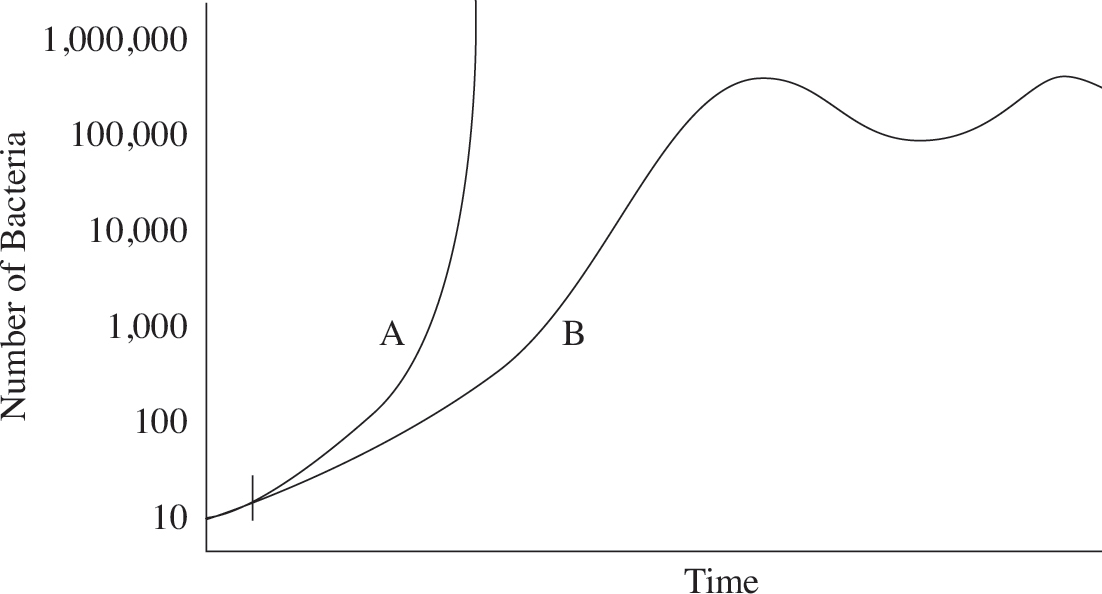
21. Which of the following represents the carrying capacity for culture B?
(A) 10
(B) 50
(C) 100,000
(D) 1,000,000
22. What could explain the differnce between culture A and culture B?
(A) Culture B started with more bacteria than culture A.
(B) Culture A was grown with a competitive inhibitor.
(C) Culture B was not measured as often.
(D) Culture A has not yet exhausted its space and resources.
23. In plants, the process of phototropism in which an organism responds to a light stimulus would be best exemplified by
(A) a sunflower photographed pointing one direction in the morning and another direction at night.
(B) a vine climbing and twisting around a trellis.
(C) a flowering tree that blooms only in the springtime.
(D) a flower that changes color to attract more pollinators.
24. Females with Turner’s syndrome have a high incidence of hemophilia, a recessive, X-linked trait. Based on this information, it can be inferred that females with this condition
(A) have an extra X chromosome
(B) have an extra Y chromosome
(C) have one less X chromosome than normal
(D) have one less Y chromosome than normal
25. When a retrovirus inserted its DNA into the middle of a bacterial gene, it altered the normal reading frame by one base pair. This type of mutation is called
(A) duplication
(B) translocation
(C) inversion
(D) frameshift mutation
26. The principal inorganic compound found in living things is
(A) carbon
(B) oxygen
(C) water
(D) glucose
27. Metafemale syndrome, a disorder in which a female has an extra X chromosome, is the result of nondisjunction. This failure in oogenesis would first be apparent when
(A) the homologous chromosomes are lined up in the middle
(B) the sister chromatids are lined up in the middle
(C) the nuclear envelope breaks down before meiosis
(D) the homologous chromosomes are pulling apart
28. Suppose scientists discovered in the fossil record or molecular biology that tiger-like ancestors lived for millions of years before a mutation occurred. This mutation caused a striped phenotype that allowed the animals with this mutation to feed and reproduce at a much faster rate due to this new camouflage adaptation. Which theory of evolution would this discovery support?
(A) Gradualism
(B) Punctuated equilibrium
(C) Genetic drift
(D) Migration
29. E. Coli have rod-shaped cells that closely resemble cylinders. Which size E. Coli cell (measured in µm) would be most metabolically efficient?
(A) radius = 0.5, height = 1.5
(B) radius = 0.5, height = 2
(C) radius = 1, height = 3
(D) radius = 1, height = 4
Questions 30–32 refer to the following passage.
The following are important pieces of replication and transcription machinery:

30. Which of the following figures would be present without helicase?
(A) 
(B) 
(C) 
(D) 
31. What might have occurred to produce the following situation?
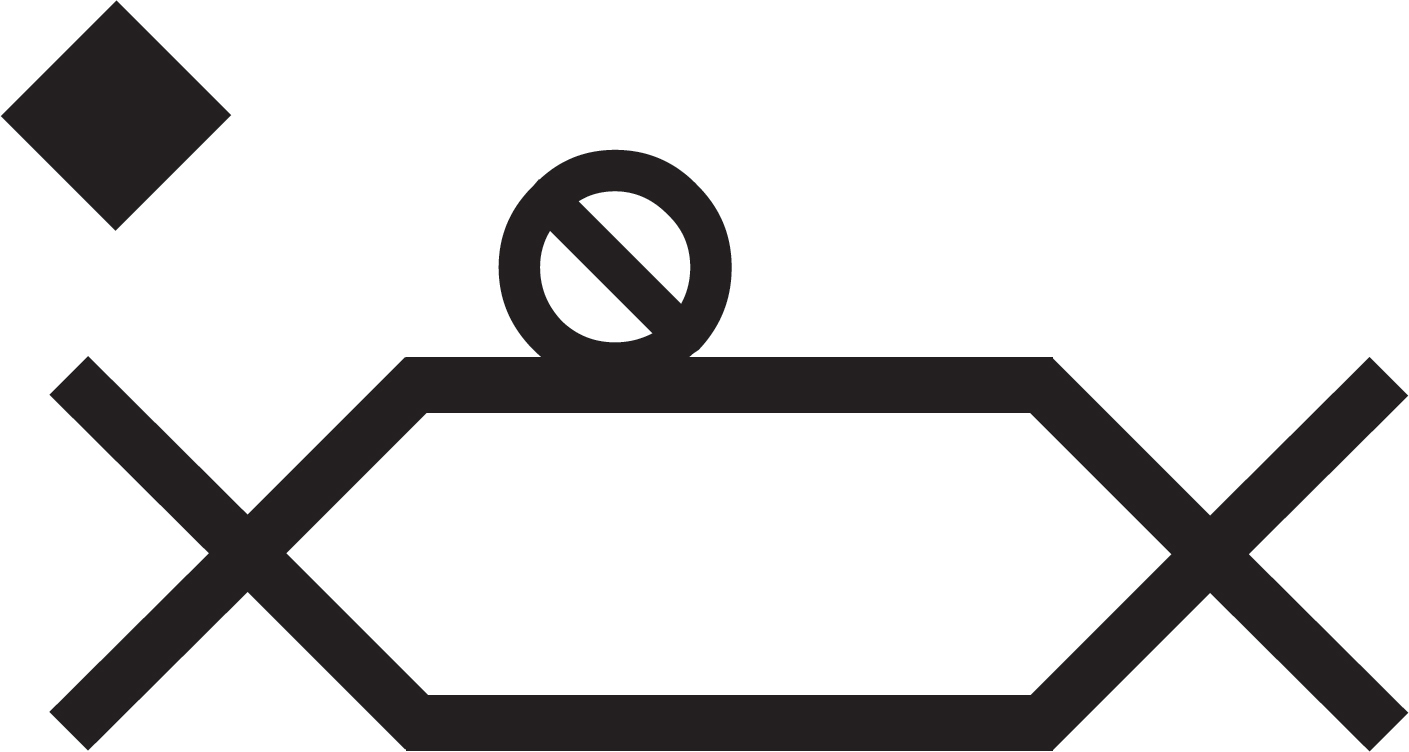
(A) Stalled DNA replication
(B) Initiation of transcription
(C) Repression of transcription
(D) Crossing-over in meiosis
32. Put these four situations in the correct order:
I. 
II. 
III. 
IV. 
(A) I, III, IV, II
(B) I, IV, II, III
(C) IV, I, III, II
(D) I, III, II, IV

33. Which process is demonstrated in the figure above?
(A) Kreb’s cycle
(B) Photosynthesis
(C) Glycolysis
(D) Fermentation
34. Avery, MacLeod, and McCarty performed a transformation experiment in which they added DNAse, protease, and RNAse to degrade DNA, proteins, and RNA respectively. They found no change in bacteria treated with protease and RNAse, but the transformation did not occur in those treated with DNAse. These results are most consistent with which of the following conclusions?
(A) The double helix is the structure of a DNA molecule.
(B) DNA is the hereditary material.
(C) DNA replication is semiconservative.
(D) DNA polymerase adds bases to only the 3′ side of DNA.
35. Which of the following processes occur in the cytoplasm of an eukaryotic cell?
I. DNA replication
II. Transcription
III. Translation
(A) I only
(B) III only
(C) II and III only
(D) I, II, and III
36. Crossing-over during meiosis permits scientists to determine
(A) the chance for variation in zygotes
(B) the rate of mutations
(C) the distance between genes on a chromosome
(D) which traits are dominant or recessive
37. An animal cell that is permeable to water but not salts has an internal NaCl concentration of 10%. If placed in freshwater, the cell will
(A) plasmolyze
(B) swell and eventually lyse
(C) endocytose water into a large central vacuole
(D) shrivel
38. Three distinct bird species, flicker, woodpecker, and elf owl, all inhabit a large cactus, Cereus giganteus, in the desert of Arizona. Since competition among these birds rarely occurs, the most likely explanation for this phenomenon is that these birds
(A) have a short supply of resources
(B) have different ecological niches
(C) do not live together long
(D) are unable to breed
39. Lampreys attach to the skin of lake trout and absorb nutrients from its body. This relationship is an example of
(A) commensalism
(B) parasitism
(C) mutualism
(D) gravitropism
40. The nucleotide sequence of a template DNA molecule is 5′-C-A-T-3′. An mRNA molecule with a complementary codon is transcribed from the DNA. What would be the sequence of the anticodon that binds to this mRNA?
(A) 5′-G-T-A-3′
(B) 5′-G-U-A-3′
(C) 5′-C-A-U-3′
(D) 5′-U-A-C-3′
41. Viruses are considered an exception to the cell theory because they
(A) require a host cell
(B) do not contain a genome
(C) do not contain a nuclei
(D) cannot evolve via mechanisms that cells evolve from
Questions 42–44 refer to the following passage.
It is difficult to determine exactly how life began. Answer the following questions as if the following data had been collected billions of years ago.
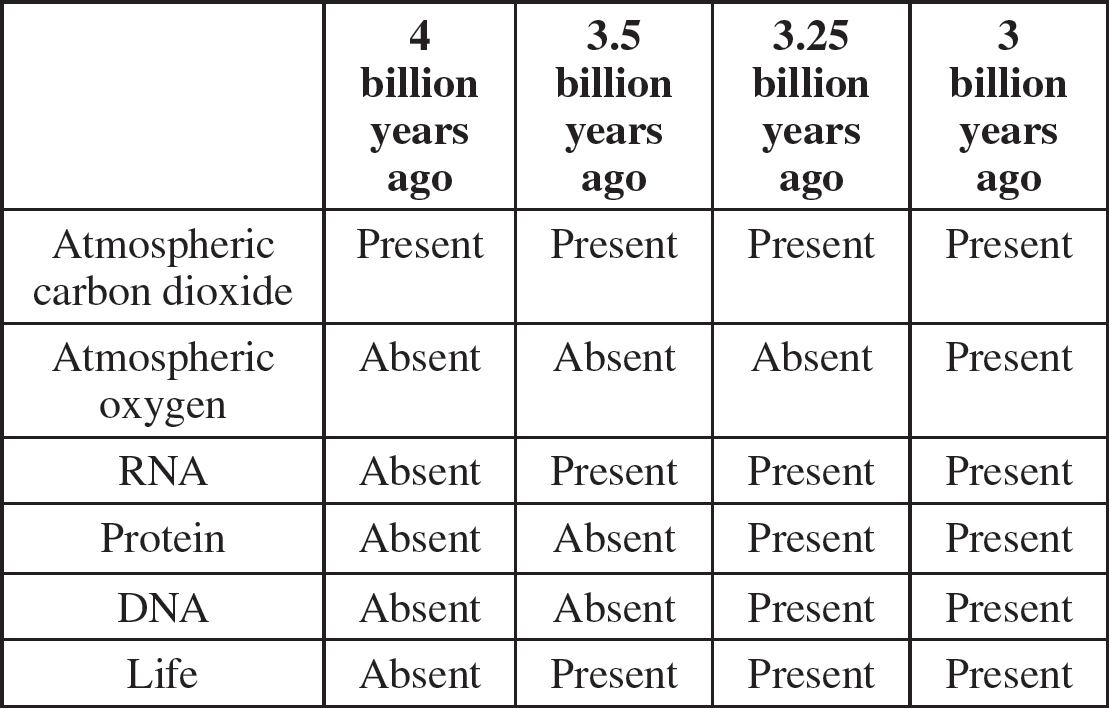
42. Which best describes the origin of life according to the data?
(A) Life required an environment with atmospheric oxygen and any type of nucleic acids.
(B) Life required an environment with atmospheric carbon dioxide, but not atmospheric oxygen.
(C) Life required an environment with self-replicating nucleic acids that can take on many shapes.
(D) Life required an environment with nucleic acids and proteins, but not atmospheric oxygen.
43. When is the earliest that functional ribosomes could have been found?
(A) Between 4 billion and 3.5 billion years ago
(B) Between 3.5 billion and 3.25 billion years ago
(C) Between 3.25 billion and 3 billion years ago
(D) Between 3 billion years ago and the present
44. Photosynthesis likely began billion years ago when the first appeared.
(A) 4.5; autotrophs
(B) 3.2; autotrophs
(C) 3.5; heterotrophs
(D) 3.2; heterotroph
45. The sequence of amino acids in hemoglobin molecules of humans is more similar to that of chimpanzees than it is to the hemoglobin of dogs. This similarity suggests that
(A) humans and dogs are more closely related than humans and chimpanzees
(B) humans and chimpanzees are more closely related than humans and dogs
(C) humans are related to chimpanzees but not to dogs
(D) humans and chimpanzees are closely analogous
46. Two individuals, one with type B blood which can be IBi or IBIB and one with type AB blood with genotype IAIB, have a child. The probability that the child has type O blood which is caused by genotype ii, is
(A) 0%
(B) 25%
(C) 50%
(D) 100%
Questions 47 and 48 refer to the following bar graph, which shows the relative biomass of four different populations of a particular food pyramid.
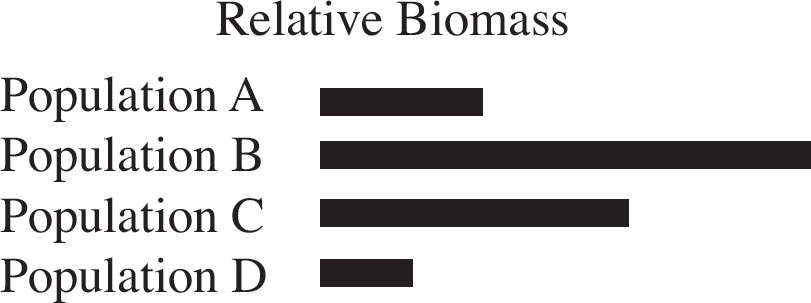
47. The largest amount of energy is available to
(A) population A
(B) population B
(C) population C
(D) population D
48. Which of the following would be the most likely result if there was an increase in the number of organisms in population C?
(A) The biomass of population D will remain the same.
(B) The biomass of population B will decrease.
(C) The biomass of population A will steadily decrease.
(D) The food source available to population C would increase.
Questions 49–52 refer to the following illustration and information.
The cell cycle is a series of events in the life of a dividing eukaryotic cell. It consists of four stages: G1, S, G2, and M. The duration of the cell cycle varies from one species to another and from one cell type to another. The G1 phase varies the most. For example, embryonic cells can pass through the G1 phase so quickly that it hardly exists, whereas neurons are arrested in the cell cycle and do not divide.
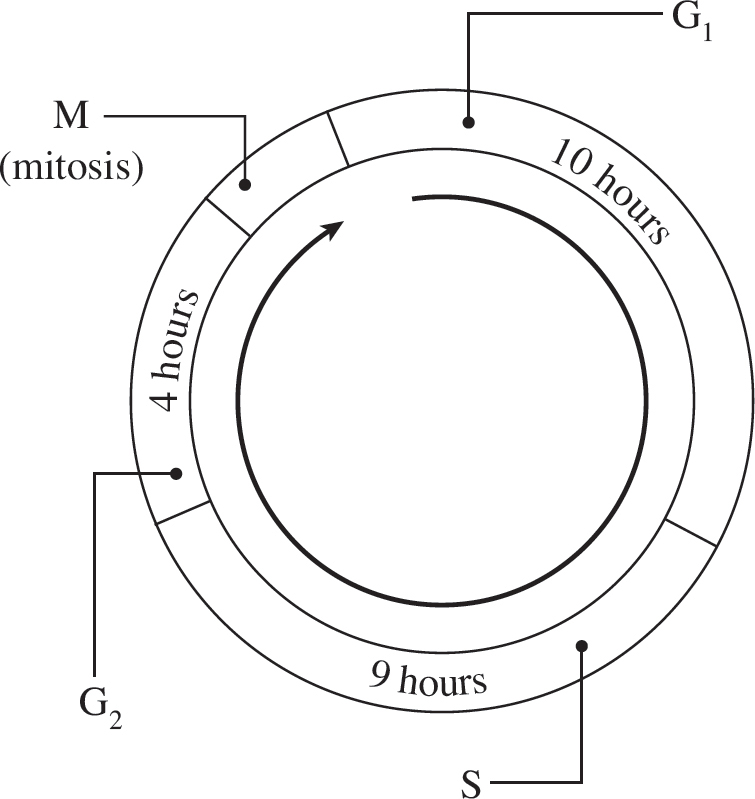
49. During which phase do chromosomes replicate?
(A) G1
(B) S
(C) G2
(D) M
50. In mammalian cells, the first sign of mitosis beginning is the
(A) appearance of chromosomes
(B) separation of chromatids
(C) disappearance of the cell membrane
(D) replication of chromosomes
51. If the cell cycle fails to progress, which of the following is NOT a possible explanation?
(A) There are inadequate phosphate groups available for the cyclin dependent kinase.
(B) A tumor suppressor protein has signaled for apoptosis.
(C) A cyclin is unable to release from its cyclin dependent kinase.
(D) An inhibitor of a cyclin gene has been highly expressed.
52. Since neurons are destined never to divide again, what conclusion can be made?
(A) These cells will go through cell division.
(B) These cells will be permanently arrested in the G0 phase.
(C) These cells will be permanently arrested in the M phase.
(D) These cells will quickly enter the S phase.
Questions 53–56 refer to the following figures which show 5 species of insects that were discovered on a previoulsy unknown island and were named as shown in the table. Proteomic analysis was performed on a highly conserved protein in the insects and the number of amino acid differences was calculated and included in the table below. The scientists used this data to create the phylogenetic tree shown below with positions labeled I, II, III, and IV as well as O, P, Q, R, and S.

53. Based on the data, which is the LEAST possible location for Gerdellen to be placed?
(A) Position O
(B) Position P
(C) Position R
(D) Position S
54. Which location contains the oldest common ancestor?
(A) Position I
(B) Position II
(C) Position III
(D) Position IV
55. Which species is the outgroup?
(A) Snippeiq
(B) Fixxels
(C) Snorflak
(D) Sqellert
56. Which 2 species would you expect to have the most shared derived characters?
(A) Snippeiq and Sqellert
(B) Gerdellen and Sqellert
(C) Snorflak and Gerdellen
(D) Snorflak and Fixxels
Questions 57 and 58 refer to the data below concerning the general animal body plan of four organisms.

Note: + indicates a feature present in an organism.
57. The two most closely related organisms are
(A) sea anemone and hagfish
(B) eel and salamander
(C) hagfish and eel
(D) sea anemone and salamander
58. The correct order of evolution for the traits above is
(A) jaws – vertebral column – walking legs
(B) walking legs – jaws – vertebral column
(C) jaws – walking legs – vertebral column
(D) vertebral column – jaws – walking legs
59. Pre- and post-zygotic barriers exist that prevent two different species from producing viable offspring. All of the following are pre-zygotic barriers EXCEPT
(A) anatomical differences preventing copulation
(B) different temporality of mating
(C) sterility of offspring
(D) incompatible mating songs
60. Birds and insects have both adapted wings to travel by flight. The wings of birds and insects are an example of
(A) divergent evolution
(B) convergent evolution
(C) speciation
(D) genetic drift
STOP
END OF SECTION I
IF YOU FINISH BEFORE TIME IS CALLED, YOU MAY CHECK YOUR WORK ON THIS SECTION. DO NOT GO ON TO SECTION II UNTIL YOU ARE TOLD TO DO SO.
Section II
BIOLOGY
SECTION II
6 Questions
Writing Time—90 minutes
Directions: Questions 1 and 2 are long free-response questions that should require about 25 minutes each to answer and are worth 8–10 points each. Questions 3 through 6 are short free-response questions that should require about 10 minutes each to answer and are worth 4 points each.
Read each question carefully and completely. Write your response in the space provided following each question. Only material written in the space provided will be scored. Answers must be written out in paragraph form. Outlines, bulleted lists, or diagrams alone are not acceptable unless specifically requested.
1. The human retina has two types of photoreceptors, rods and cones, which respond to light stimuli. Stimulation of photoreceptors is essential for the organisms to respond to visual stimuli. When the rods and cones absorb a photon, a molecule called retinal alters their conformation and allows a sodium channel to close.
The response of rods—that is, the voltage—can be measured with a microelectrode. When a rod cell is bathed in vitreous humor, the fluid found inside the eyeball, it has a resting membrane potential of –40mV. As the rod is exposed to light, the membrane potential becomes more negative, or hyperpolarized.
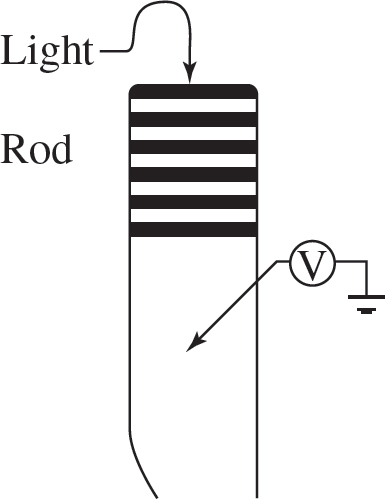
Figure 1

Figure 2
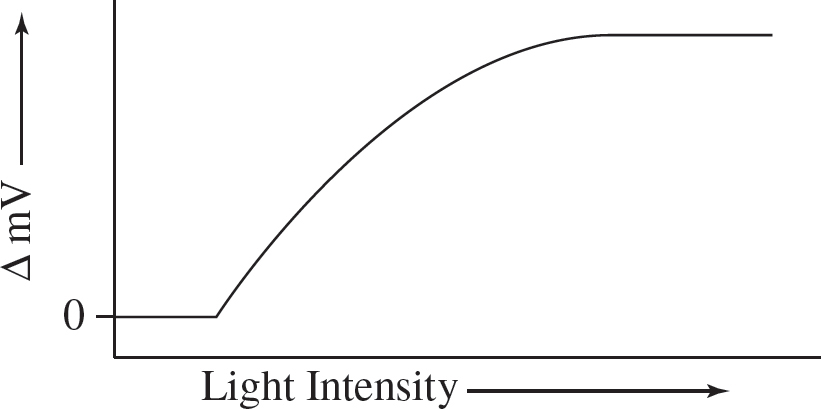
Figure 3
In Experiment 1, a rod was stimulated and its responses measured. Figure 2 shows the hyperpolarizations resulting from two light intensities (two separate stimuli are depicted on the same graph). Figure 3 is a plot of intensity versus hyperpolarization (depicted as a change in mV from –40mV).
In Experiment 2, the Na+ was removed from the vitreous humor. The resting membrane potential changed to –65mV and was unaffected by a light stimulus.
(a) Explain why the ability to respond to a visual stimulus would be naturally selected. Would a rod receptor with a resting membrane potential of –65mV be selected for?
(b) Explain how the control in Experiment 1 would differ from the control in Experiment 2.
(c) Describe the relationship between a stimulus and hyperpolarization. Use evidence from the data.
(d) If the rods were bathed in fluid with a high sodium content, explain how the resting membrane potential would change. How does the sodium change the resting membrane potential?
2. In a forest there are two types of wildflowers: red flowers and yellow flowers. The red flowers are the food of choice for a population of rodents. The yellow flowers are the food of choice for a type of mountain deer. Both populations of animals appear to be evenly distributed throughout the forest, but it often looks like there are more red flowers on one side of the forest than on the other side.
A researcher wanted to determine if the red flowers preferred to grow on the western side of the forest and the yellow preferred to grow on the eastern side of the forest. For 5 years, she counted the number of red flowers on each side of the forest. The results are in Table 1.
|
|
Western Red Flowers |
Eastern Red Flowers |
|
2006 |
1,527 |
986 |
|
2007 |
1,324 |
1,011 |
|
2008 |
1,478 |
876 |
|
2009 |
1,048 |
788 |
|
2010 |
1,140 |
800 |
|
Average |
1,304 |
892 |
|
Standard Error |
208 |
103 |
Table 1
(A) Explain how biotic and abiotic factors affect where plants grow.
(B) Construct a graph of averages and standard error for the western and eastern flowers.
(C) Perform a chi-squared analysis using the average data for both flower types.
(D) Using your chi-squared analysis data, explain if you can reject the null hypothesis that flowers do not prefer the western side.
3. Schizosaccharomyces pombe, or fission yeast, has a cell cycle that resembles that of mammalian cells. During interphase, fission yeast grow to twice their normal size, and at the end of mitosis both daughter offspring are equal in size to the original parent cell. Genes that regulate the division of fission yeast are known as cell-division cycle, or cdc, genes.
The following experiments were conducted to determine the effect of cdc gene mutations on yeast cell division.
Experiment 1
In order to determine the effect of cdc mutations, wild-type cells and mutants were grown at 37°C in the presence of a radioactive drug that specifically binds to the spindle apparatus. Stages of the cell cycle were elucidated for both cell types incubated at this temperature. At 37°C, temperature-sensitive cdc mutants were unable to re-enter interphase after mitosis. The illustration below depicts the results for wild-type cells and cdc mutants.
Experiment 2
Cdc mutants were initially incubated at 25°C for 30 minutes and several rounds of mitosis occurred. Separate colonies were then exposed to temperatures near 37°C at different times during the cell cycle. For each colony, the cell cycle was arrested immediately after the last phase of mitosis.
(A) Describe how a mutation in DNA can lead to a protein that no longer functions correctly.
(B) Explain the impact of the radiolabeled dye on the cell cycle.
(C) Predict what would happen if the cdc mutants were initially incubated at 37°C and then switched to 25°C.
(D) Justify your prediction.

Figure 1
4. A prairie was sampled by entomological researchers to determine the species abundance and diversity. Three years into the study a fire swept through the prairie. Two years later quadrant sampling was completed again. Results were compiled in the table below.
|
Organism |
Before Fire |
2 years after fire |
|
Hazel-hued bugs |
3 |
10 |
|
Hairy bear moths |
14 |
9 |
|
Telluride tiger beetles |
6 |
15 |
|
Golden-winged butterflies |
21 |
10 |
(A) Describe what happened to the biodiversity of the ecosystem before and after the fire.
(B) Explain your description in (A) using the Simpson’s Diversity Index.
(C) Predict what would happen to the biodiversity if there was an invasive insect species introduced into this ecosystem.
(D) Justify your prediction.
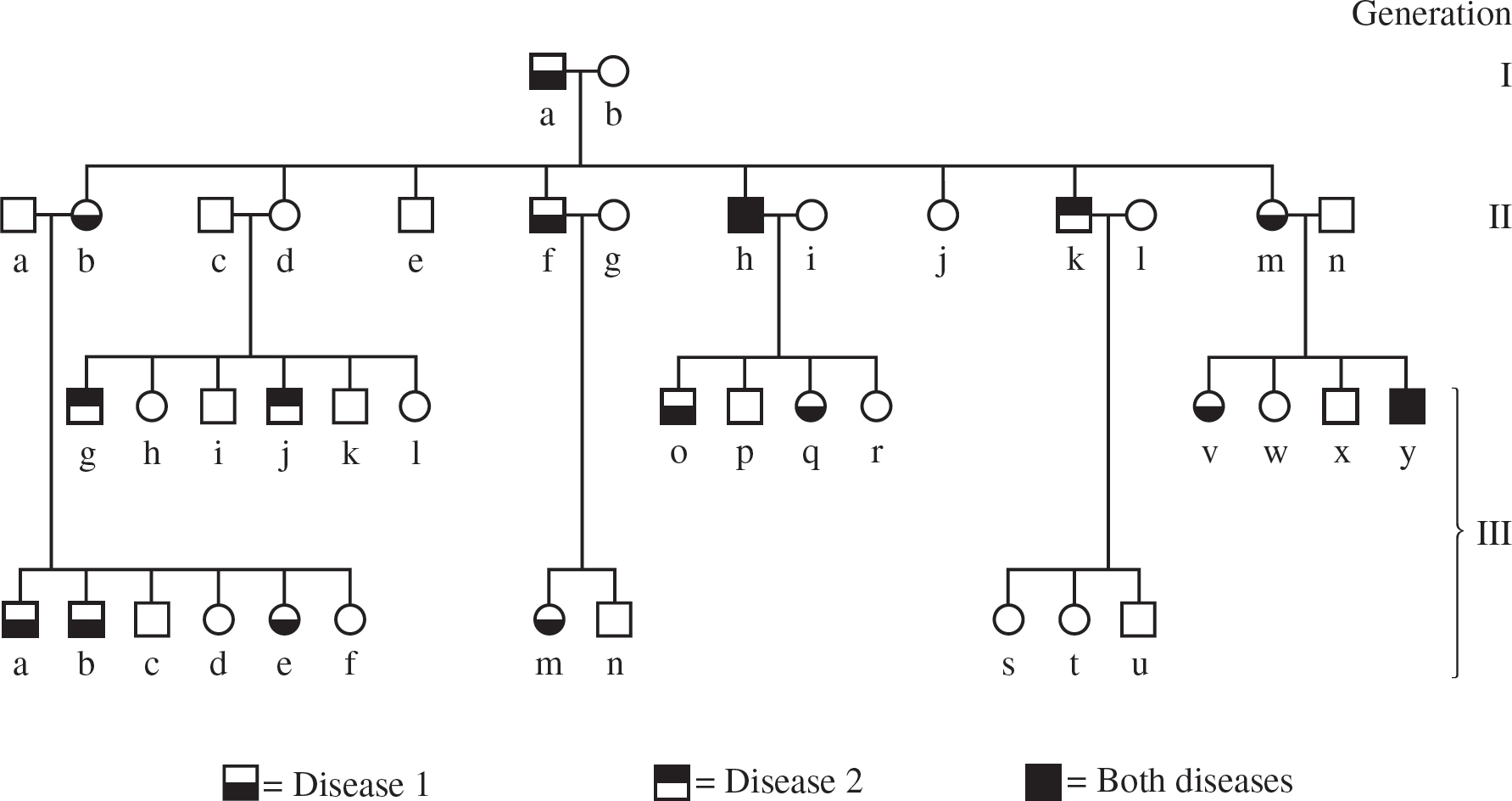
The diagram above is a pedigree of three generations showing the occurrence of two genetically transmitted diseases. Phenotypes of affected individuals are shown. Circles represent females, and squares represent males. Assume that the diseases are rare, unlinked, and that individuals not blood related to I-a and I-b (“in-laws”) do not have either disease-producing allele.
(A) Explain how it is possible for a person to have two rare unlinked genetic diseases at the same time.
(B) Calculate the ratios of affected males and affected females for Disease 2.
(C) Identify the likely inheritance patterns of Disease 1 and Disease 2.
(D) Describe how inheritance patterns are shaped by the chromosomes upon which the genes are located.
6. In this fictional scenario, an enzyme was discovered in reptile feces, gertimtonase, that was believed to aid in digestion and water retention. Researchers wanted to know how the enzyme’s activity level changed with varying temperature. The scientists took fecal samples of Russian tortoises that were living in varying environmental temperatures. The data was summarized in the following graph.
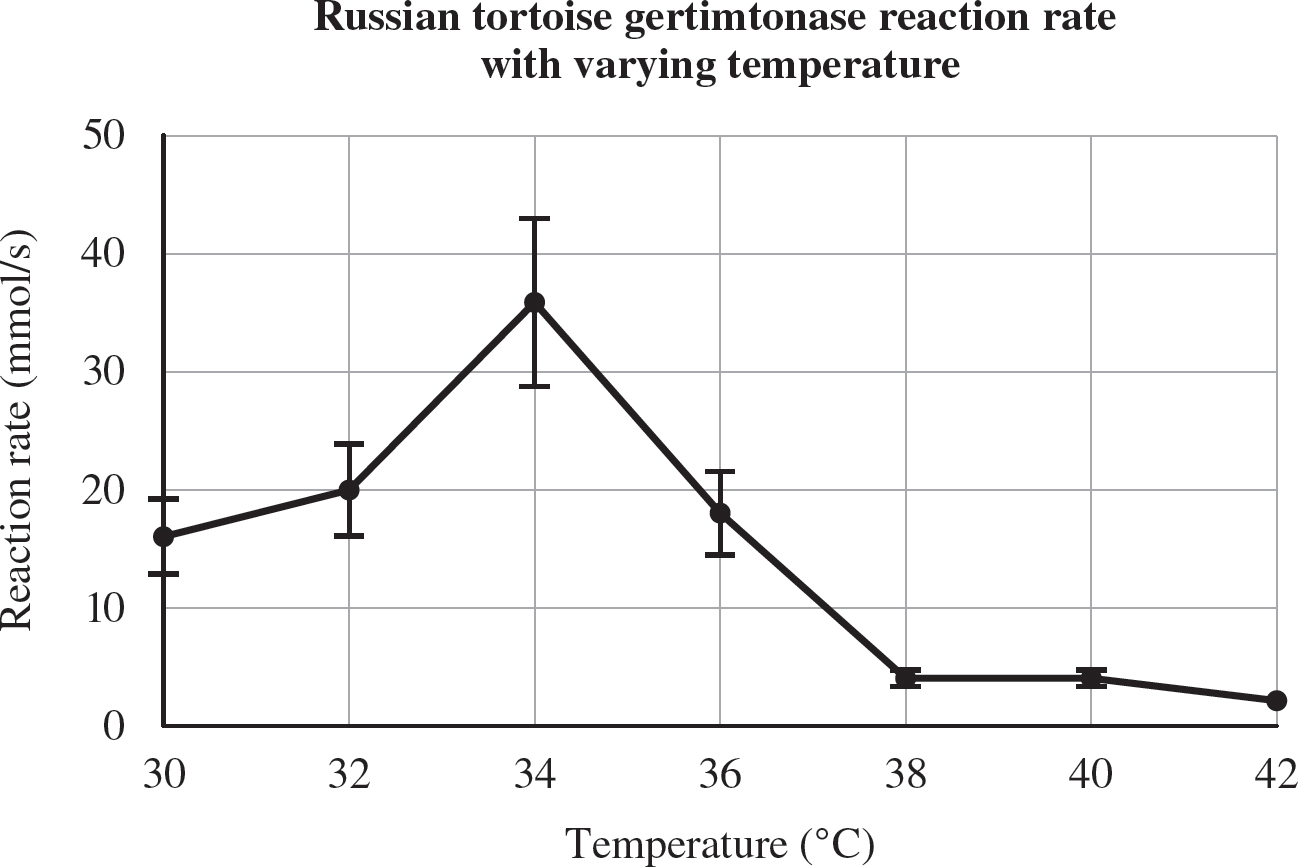
(A) Describe how you can determine that tortoises raised at 34°C had the highest variability in enzyme reaction rates.
(B) Reptiles in the study needed to have a gertimtonase reaction rate exceeding 10 mmol/s for an observed improvement in water retention. Describe the range of temperatures that Russian tortoises could be raised in to achieve this benefit.
(C) Desert tortoises live in environments where the ground temperature can exceed 60°C. Using the data above, predict and justify how the graph would look for desert tortoise gertimtonase.
(D) Explain at a molecular level how the temperature change might affect gertimtonase.
STOP
END OF EXAM